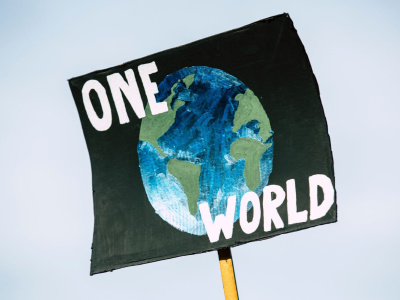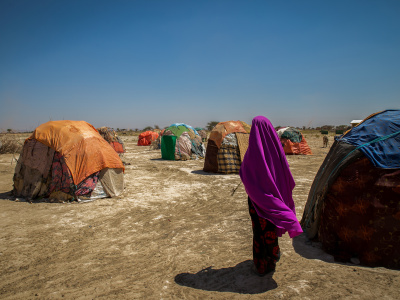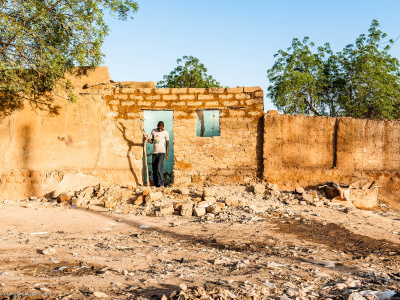
COP27 can do more for women bearing the brunt of climate change and conflict
14 November will be ‘gender day’ at COP27. Could this be an opportunity to support women in the Sahel in their effort to tackle the pressing challenges of climate change, conflict and gender inequalities? What they need are integrated policies, more climate finance and better regional cooperation. COP27 will hopefully consider the needs of fragile states and conflict-affected people, including women. Support for local women’s organisations would be a good start.
Five years after Morocco hosted COP22, the UN’s biggest climate change conference is back in Africa. COP27, which is taking place in Sharm El-Sheikh, Egypt, has a day dedicated to gender equality. This is much needed.
Women are heavily impacted by climate change – and in different ways than men. Around 80% of people who are displaced by climate change are women. When disasters hit, women lose their homes, crops and livelihoods. Women have less means to look for alternatives through circular mobility and migration and face harmful gender norms and sexual violence while seeking protection.
Fragile states like those in the Central Sahel face a dual challenge: they are climate hotspots and have to deal with insecurity and poor governance – and climate change can exacerbate conflicts and governance challenges. It puts additional stress on people, and in particular on women who face structural gender inequalities on top of the multidimensional crisis. Despite this, women’s contributions to environmental peacebuilding and addressing climate-related security challenges are underused.
So far, gender has not featured high on the agenda of global climate talks. Neither did conflicts. But in light of the pressure countries like Mali, Burkina Faso and Niger face, decision-makers at COP27 cannot ignore the links between gender, climate and insecurity any longer.
Drawing on findings on how regional actors are tackling these challenges in the Central Sahel, we zoom in on three obstacles that prevent a stronger integration of gender and conflict-sensitive perspectives in climate action.
Obstacle 1: Policies in silos
Gender is unequally integrated into security and climate strategies and coordination between these two areas tends to be limited. In the Central Sahel, regional bodies have adopted security, climate change or gender policies, but most of these do not explicitly recognise the links between gender, climate change and security, and often work in parallel.
For instance, the Economic Community of West African States (ECOWAS) collects gender-disaggregated data on climate change impacts, conflicts and climate-related challenges like farmer-herder conflicts, but still makes separate reports for governments on climate change and security.
References to gender are generally stronger in regional security policies than in climate ones. For example, ECOWAS has dedicated action plans and internal structures on gender and security, but not on gender and climate change. One explanation is that governments, institutions and civil society have used the Women, Peace and Security Agenda (WPS) as the main reference for policies on gender and conflict.

References to gender are generally stronger in regional security policies than in climate ones.
The UN Lima Work Programme (1992) and Gender Action Plan (2017) have helped to integrate gender in climate frameworks, but these plans haven’t necessarily had the same traction as the Women, Peace and Security Agenda. A potential explanation is that WPS action plans have existed since 2005 (and over 100 countries have adopted one) and a resolution by the UN Security Council has anchored the Women, Peace and Security Agenda at a high level of decision-making.
Amidst many priorities and urgent needs in the Central Sahel, making sure that climate, gender and security policies work in harmony and have a greater combined effect is a tall order. A pragmatic approach should focus on better mainstreaming gender across existing climate and security policies and encourage actors to prioritise actions that can bring multiple dividends. For example, when updating their security and climate strategies, regional and international organisations, but also governments, can mainstream gender in context analysis, monitoring and action plans, based on a gender-budgeting approach.
This requires better coordination between different policy areas and policymakers. A good example of this is the African Union climate and security cluster, which the AU Commission created to get its climate and security departments to talk to each other.
There are examples of integrated programming bringing multiple dividends too. The Regional Sahel Pastoralism Support Project – or PRAPS – helps pastoralists to better manage both natural resources impacted by climate change, and conflicts, via local dialogue that includes women. But changing ways of working requires time and investment.
Obstacle 2: Insufficient climate finance going to women
There is a huge gap in gender-sensitive climate finance. Less than 3% of adaptation funds for least developed countries go to gender equality measures, such as supporting women’s ability to take loans for local adaptation schemes. Considering that adaptation finance only makes up about 20% of all climate finance, what goes to gender equality is very low.
Meanwhile, gender equality has been a ‘marginal concern’ in mitigation efforts, which capture the majority of climate finance, especially from the private sector. Private companies need to rise to the challenge, or else women will continue to be excluded from the economic benefits of the energy transition. There are good examples of women who have been included in mitigation efforts across Africa. But evidence of similar initiatives tackling the links between gender, climate and security in conflict-affected regions is scarce.
Financial compensations for loss and damage have also been limited – and women in particular struggle to access compensation when their businesses are disrupted. This is out of touch with reality around the globe. Women’s livelihoods rely heavily on natural resources and are disproportionately affected by climate disasters and environmental degradation.
Obstacle 3: Risk of tokenism and duplication
National climate strategies increasingly consider gender, but there is much room for improvement. Women should not be mentioned only for the sake of it or to stress their vulnerability. Policies can capitalise more on women’s adaptation knowledge.
For example, in certain regions across the Sahel, women are more familiar with land restoration techniques like ‘zaï’ (a cultivation technique that consists of placing manure, water and seeds in small pits dug in the soil), because they are the ones applying them in the dry season, when men are away. Policy responses should also apply gender budgeting and earmarked funding for gender-sensitive initiatives.
National climate strategies increasingly consider gender, but there is much room for improvement. Women should not be mentioned only for the sake of it or to stress their vulnerability.

Another hurdle is the lack of a clear division of labour and the risk of duplication at the regional level, including in the Central Sahel. The G5 Sahel, a regional body bringing together five countries in the Sahel, is in the process of adopting a new gender policy in addition to its security and development strategy. ECOWAS and smaller organisations like the Permanent Interstate Committee for drought control in the Sahel (CILSS) are adopting (separate) policies on climate change, gender and security.
Countries’ overlapping membership in regional bodies and their multiple challenges could push them to strengthen regional cooperation. But this implies overcoming the interstate politics and tensions that are at the source of these overlaps, with certain countries preferring to invest in the regional bodies that best support their interests. Still, regional cooperation is possible around shared goals, such as the need for good data. For instance, the West African Economic and Monetary Union and the G5 Sahel are working with ECOWAS to grow their early warning system.
What can leaders do at COP27?
This year, leaders at COP can do more for fragile regions and for women bearing the brunt of climate change and conflict. So far, commitments to support women’s climate resilience are a ‘drop in the ocean’. To meet the immense challenges women in the Sahel face, making sure for example that more climate finance goes to local women’s organisations, could ensure that pressing challenges are addressed jointly, flexibly and in line with local priorities. This would also guarantee that existing local knowledge informs responses.
Another logical step is having more women negotiators at the table. These types of commitment, not empty promises, can help COP27 make a difference. As host, Egypt can encourage such concrete steps during and beyond ‘gender day’, with the hope that other countries will follow.
The views are those of the authors and not necessarily those of ECDPM.








